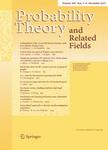-
作者:VUOLLEAPIALA, J
摘要:Let (X(t), P(x)) be a rotation invariant (RI) strong Markov process on R(d)\{0} having a skew product representation [\X(t)\, theta(At)], where (theta(t)) is a time homogeneous, RI strong Markov process on S(d-1), \X(t)\ and theta(t) are independent under P(x) and A(t) is a continuous additive functional of \X(t)\. We characterize the rotation invariant extensions of (X(t), P(x)) to R(d). Two examples are given: the diffusion case, where especially the Walsh's Brownian motion (Brownian hedgeho...
-
作者:GREVEN, A; DENHOLLANDER, F
作者单位:Utrecht University
摘要:Let (eta(n)) be the infinite particle system on Z whose evolution is as follows. At each unit of time each particle independently is replaced by a new generation. The size of a new generation descending from a particle at site x has distribution F(x) and each of its members independently jumps to site x +/- 1 with probability (1 +/- h)/2, h is-an-element-of [0, 1]. The sequence {F(x)} is i.i.d. with uniformly bounded second moment and is kept fixed during the evolution. The initial configurati...
-
作者:RACHEV, ST; RUSCHENDORF, L
作者单位:University of Munster
摘要:A new ideal metric of order r > 1 is introduced on R(k) and a thorough analysis of its metric properties is given. In comparison to the known ideal metric of Zolotarev this new metric allows estimates from above by pseudo difference moments and thus allows applications to stable limit theorems. As applications we give the right order Berry-Esseen type result in the stable case, obtain the limiting behaviour of multivariate summability methods and discuss the approximation problem by compound P...
-
作者:PERKINS, E
摘要:A strong equation driven by a historical Brownian motion is used to construct and characterize measure-valued branching diffusions in which the spatial motions obey an Ito equation with drift and diffusion depending on the position of an individual and the entire population.
-
作者:GORDON, Y
摘要:Let (x(i)*)i = 1n denote the decreasing rearrangement of a sequence of real numbers (x(i))i = 1n. Then for every i not-equal j, and every 1 less-than-or-equal-to k less-than-or-equal-to n, the 2-nd order partial distributional derivatives satisfy the inequality, partial derivative 2/partial derivative x(i) partial derivative x(j) [GRAPHICS] less-than-or-equal-to 0. As a consequence we generalize the theorem due to Fernique and Sudakov. A generalization of Slepian's lemma is also a consequence ...


